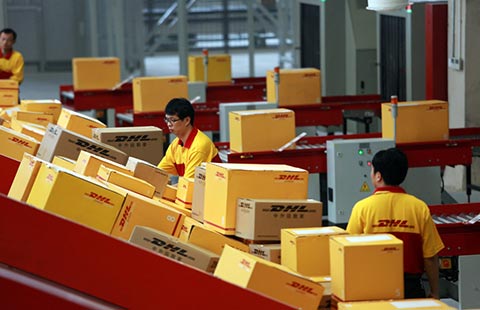

|
 |
|
Staff members work on the second double-track of the Lanzhou-Xinjiang?Railway in?Dongping county of Lanzhou, Gansu province, Nov 8, 2012. [Photo/Xinhua] |
Infrastructure investment will regain pace next year in the wake of the country's economic transformation and the new government assuming its post, Moody's Investors Service said on Thursday.
Ivan Chung, a senior analyst with Moody's who specializes in infrastructure finance, said that China's demand for infrastructure investment will remain robust in the fourth quarter and next year, with economic growth back on track. Growth of accumulated fixed-asset investment was 20.5 percent in the first nine months of the year, compared with 24.9 percent in the same period last year.
According to the Ministry of Transport, investment growth in China's transport system has rebounded in the third quarter to a 2.5 percent increase, from a 7.4 percent and a 5.4 percent decline in the previous two quarters. Growth in October was even higher at 21.3 percent.
"We estimate that the investment growth will maintain its modest recovery in the last two months of the year, making the total transport investment in 2012 on par with that of the previous year," said He Jiangzhong, spokesman with the ministry, at a press conference on Thursday.
Total fixed-asset investment was 1.45 trillion yuan ($232.7 billion) in 2011.
"Undoubtedly, an increase in investment demand in the months to come will come from the assumption of the new local governments' officials and a traditional investment fever at the end of the year," Chung said.
But more importantly, Chung said, it will be a result of the changes in the social and economic structure of the world's second-largest economy.
Due to the continuous urbanization process, a growing urban population will generate demand for a better public transportation system, as well as more affordable housing projects.
In September, the National Development and Reform Commission approved 23 urban track-traffic projects, nearly the double of the total number of projects approved in the last three years. The total investment volume of these projects adds up to 832.7 billion yuan.
Chen Peng, a transport industry analyst with China Chengxin International Credit Rating, said the city track-traffic sector will see rapid development as demand is on the rise.
Meanwhile, investment on affordable housing projects only accounts for less than 2 percent of China's total government spending, much lower than the global average, so there is still much room for improvement in that area, Chung said.
In addition, many factories moving to inland provinces in search of lower costs will also boost demand for infrastructure such as railway, airports, and electrical grids in underdeveloped areas.
However, achieving the ambitious investment plan will not be easy, as cash-strapped authorities are facing increasing pressure amid decreasing government income.
To solve the problem, Chung said more financing channels are needed, such as bigger roles for private investors or even overseas investors, as well as debt insurance mechanisms by local governments.
Chung said future infrastructure investment will try to add more value and will be quality-focused, rather than the quantity-focused model used in the past, which is no longer sustainable. That means that upgrades to current facilities may also become a trend, he added.
For instance, as China moves up the value chain, the country now exports iPads rather than T-shirts.
"The changes may not require larger containers, but they certainly need higher service and management levels at the harbor," Chung said.
weitian@chinadaily.com.cn
 Top 10 developing countries for retail investment
Top 10 developing countries for retail investment
 Alibaba's sampling inspection procedures revealed
Alibaba's sampling inspection procedures revealed
 Top 10 best employers in China 2016
Top 10 best employers in China 2016
 Chinese drones gear up for global takeoff
Chinese drones gear up for global takeoff
 Labor of love: Graduate creates exquisite artwork with paper-rolling
Labor of love: Graduate creates exquisite artwork with paper-rolling
 Top 10 overseas M&As of Chinese auto companies
Top 10 overseas M&As of Chinese auto companies
 Chinese factories score a goal with Euro 2016
Chinese factories score a goal with Euro 2016
 Young car racer pursues dream, speed
Young car racer pursues dream, speed

